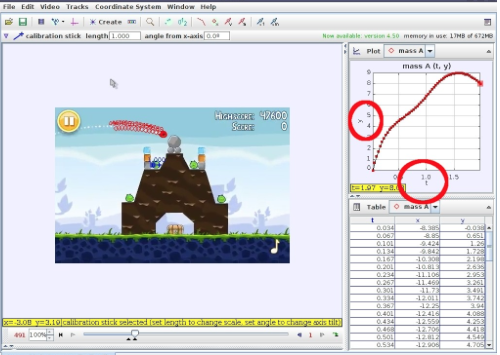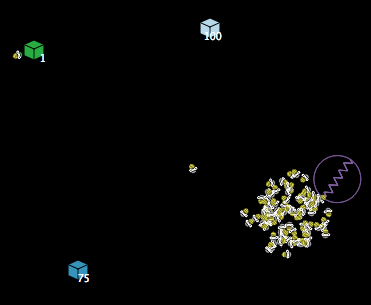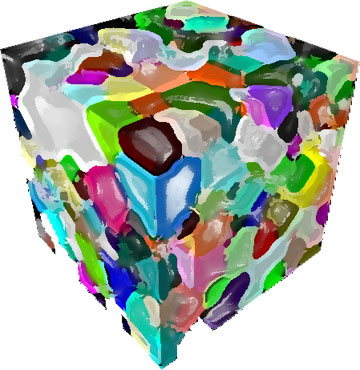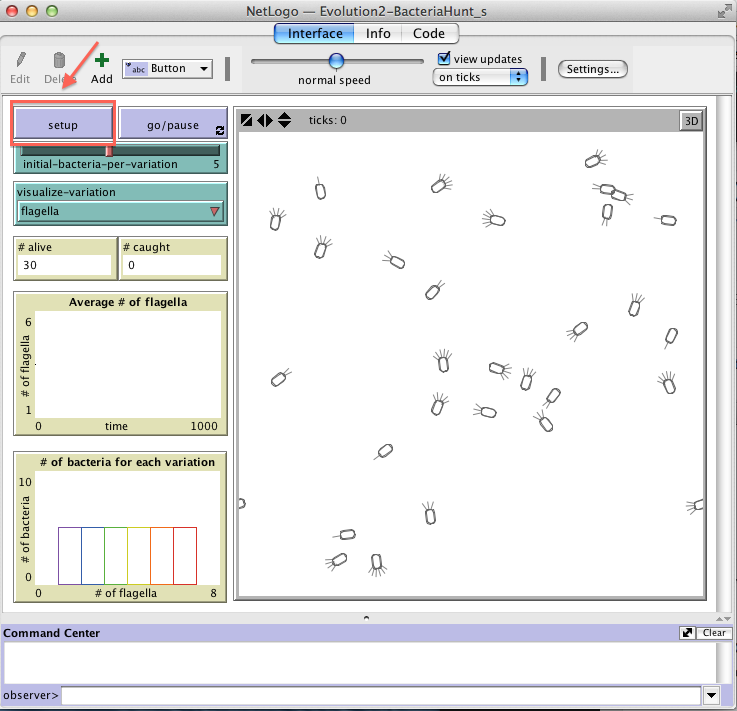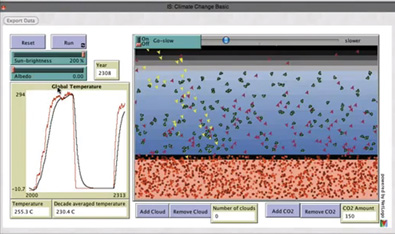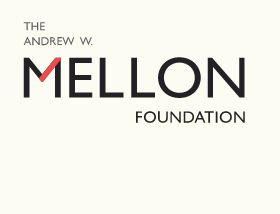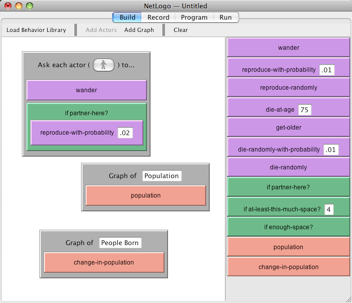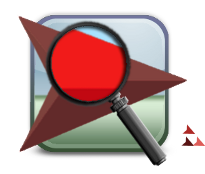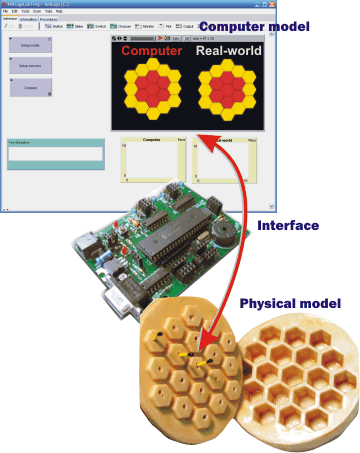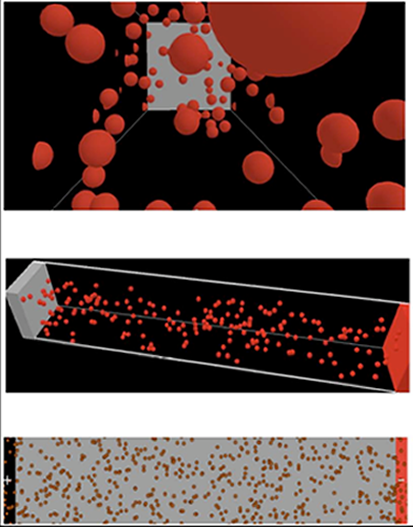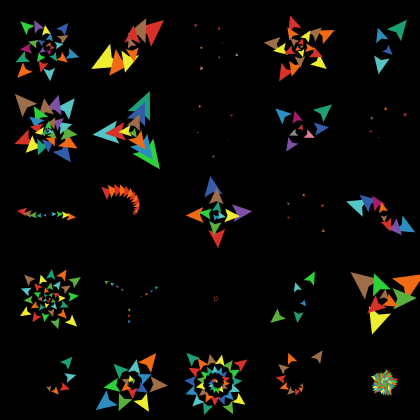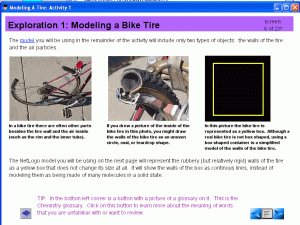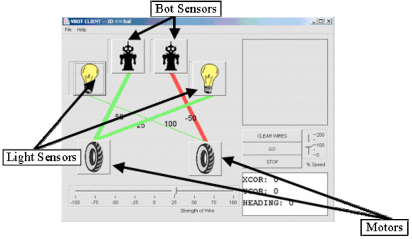Software Tools | Current Projects | Completed Projects
Current Research Projects

The CCL-Parallax Programmable Badge
This project is a collaboration between the CCL and Parallax Inc. to develop an open hardware, open software programmable badge. The badges are equipped with IR transmitters and receivers making it possible for badges to communicate with each other. The badges also include sensors, lights, and a digital display, along with open connections to add components, resulting in a low-threshold, high-ceiling tangible computing platform. Using the badges we are exploring the next generation of participatory simulations.
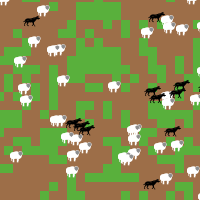
Group Based Cloud Computing
Group-Based Cloud Computing (GbCC) provides an alternative to the Initiation (teacher) - Response (student) - Evaluation (teacher) sequence of instruction typical of the classroom described above (Wells, 1993). GbCC is agent-based modeling program, powered by NetLogo Web, that allows learners to work collaboratively to participate in, author, and share models. Models developed in NetLogo Web cover a range of domain content including, but not limited to: disease transmission, population dynamics, physical phenomena, and social stratification. GbCC provides network supported, generative design based learning and teaching opportunities (Stroup, 2012).

GenEvo
This project is designed to address the huge disparity between high school biology instruction and the research practices of modern biologists. Our work combines two powerful design approaches in learning sciences, namely, agent-based modeling of emergent systems and constructionism. We use a computational modeling approach to engage students in complex systems thinking in the context of cutting-edge ideas in modern biology such as molecular genetics and genetic regulation. Our design approach, which we call emergent systems microworlds (ESM), is an attempt to make these ideas accessible to middle and high school students in different global settings (India and the United States), by engaging them in the research practices of computational modeling and complex systems thinking.
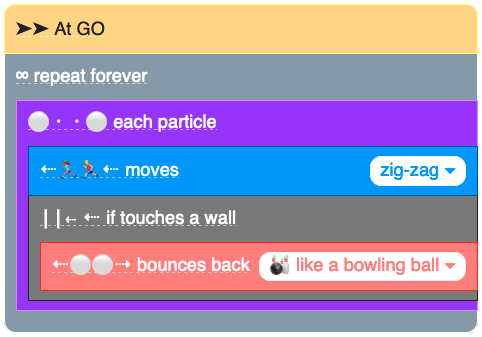
Phenomenological Programming
Phenomenological programming is a novel approach to designing introductory programming environments for science learning. In phenomenological programming, high-level primitives are designed based on students’ intuitive understanding of the real-world objects, patterns, and events. Each primitive is made up of two components: a procedural statement that indicates action and a phenomenological statement that indicates behavior.

Mind the Gap
The goal of the Mind the Gap (MTG) curricular unit is to help high school students understand important mechanisms of wealth inequality in the U.S. through the lens of complex systems with NetLogo HubNet-based participatory activities.
LevelSpace - Modeling in Levels
NSF - Cypberlearning
LevelSpace is a technical platform for running an arbitrary number of NetLogo models concurrently, and have them communicate. LevelSpace is a NetLogo extension, and will run Mac, Windows, and Linux.
LevelSpace is also a research project investigating what happens when people think between models. Prior research by our group and collaborators has shown that connecting micro-level interactions and macro-level outcomes is difficult for learners. Our research will focus on using between-model thinking as a way of bridging thinking about the relationships between micro-level interactions and macro-level outcomes between different phenomena.
Integrating Physical Computing with Agent Based Modeling (pcDuino)
NSF-Cyberlearning (EAGER)
The driving goal of this project is to increase the access by young learners to powerful expressive tools for computational thinking and modeling. We aim to do so by combining NetLogo's agent-based modeling (ABM) environment with the capacity for integrated data collection and physical computing offered by low-cost single-board computers (SBCs). For this project, our reference hardware platform is the pcDuino
CT-STEM
Computational thinking plays an increasingly important role in science, technology, engineering, and mathematics. Yet, many high school students never encounter computational thinking in their day-to-day coursework. Our project develops computational thinking activities that can be embedded in existing high school STEM courses (CT-STEM).
NSF-CE21NSF STEM-C
CT4G - Completed.
BeeSmart
The goal of this project is to help students learn complex systems concepts that cut across multiple scientific disciplines in order to provide students with organizing frameworks for science learning. We achieve this goal by combining Next Generation Science Standard (NGSS) style inquiry process with NetLogo simulation of honeybees' hive-finding behavior--a rich and intriguing phenomenon that embodies multiple complex systems concepts.
NetTango
Bringing agent-based modeling to a younger generation. A block-based interface to NetLogo. The NetTango models can be programmed very easily by novices and young children.
Theory Building
The research aims to understand the character of 1) the theories the students produce; 2) the processes by which they produce their theories; and 3) the characteristics of student learning that result. These questions are addressed through lab-based studies that introduce students to phenomena by guiding them to either articulate the aggregate-level pattern seen in data or develop agent-based computational models that represent the mechanism behind the pattern.
MaterialSim
<This project intends to rovide students and researchers with powerful agent-based simulation tools for a variety of phenomena in Materials Science, such as grain growth and solidification. Most commercial simulation packages in Engineering “black-box” their mathematical and physical models. MaterialSim is an attempt to address this issue, with "glass-box" models for crystallization, solidification, metallic grain growth and annealing. In addition, our research has suggested that the agent-based perspective may foster deeper understanding of the relevant scientific phenomena. A core feature of this design is that students, after understanding the very basic principles of the models, were able to apply that small number of rules to capture fundamental causality structures underlying behaviors in a range of apparently disparate phenomena within a domain.
Completed Research Projects
ModelSim
NSF - DRK12 Project - NSF# DRL-1020101
ModelSim is a 4-year NSF funded project focusing on the design and scaled implementation of technology-rich agent-based modeling (ABM) science curricula to address challenging topics in the physical and biological sciences.
Our extensive experience engaging children in the creation and exploration of ABMs in domains such as biology, chemistry, electricity, and probability have shown agent-based modeling to be a powerful way for a wide range of students to engage with and make sense of complex phenomena.
Materials here.
Learning Evolution through Model-Based Inquiry
NSF-REESE
This project explores the use of computational, agent-based modeling activities in STEM classrooms (at all levels) as well as science museums. Its two main objectives are to develop new ways for students to learn core concepts of evolutionary biology, and
to explore innovative activity structures for student collaboration.
Our project combines the use of agent-based modeling with emerging interactive technologies (including multi-touch tabletop surfaces, networked simulations, and mobile devices).
InquirySpace
NSF-Cyberlearning
Science should be learned in the way scientists learn, using inquiry-based learning or "extended inquiry." But finding projects for students that are feasible and interesting is a major problem that teachers face when taking this advice seriously. Projects cannot be too complex or too long; they cannot demand expensive equipment or require unusual skills. And projects must address the course learning goals. These constraints limit the range of feasible student projects. InquirySpace gives students tools, guidance and ideas that greatly expand the range and sophistication of meaningful open-ended science investigations.
Sawyer-Mellon Series on Social Epistemology
Our society faces profound environmental, political, educational, health, and economic challenges. Potential solutions to these challenges will have to rely on the best of what we know. But no sooner do we try to apply our knowledge to these challenges, than we face a series of questions about the extent of our knowledge, and what to do when there is disagreement over what we claim to know. To address these questions, we will need more than expertise in each of the relevant fields (environmental science, educational theory and practice, etc.). In addition, we will need to have a sense of how information is acquired, stored, shared, dissected, and ultimately vindicated as knowledge. In short, we will need to understand the social dimensions of knowledge production. It is precisely this topic that we will be addressing in a Sawyer Seminar comprising four conferences and complemented by related quarter-long reading groups.
DeltaTick
DeltaTick is a low-threshold visual programming interface for the NetLogo multi-agent modeling environment. It provides a graphical drag-and-drop interface that lets you build fully functional agent-based models quickly and easily. It also provides you with access to view and edit the text-based NetLogo code that is generated by any user's configuration of programming blocks.
Behavior Search
BehaviorSearch is a software tool to help with automating the exploration of agent-based models (ABMs), by using genetic algorithms and other heuristic techniques to search the parameter-space.
BehaviorSearch interfaces with the popular NetLogo ABM development platform, to provide a low-threshold way to search for combinations of model parameter settings that will result in a specified target behavior.
Reimagining Game Design
Is it possible to design a video game that will fit into youth gaming culture, yet implicitly teach valued science content? This is certainly an ambition and challenging question, however the potential benefit of success necessitates action and requires a reimagining of educational games design. In this project I explore, create, and assess design principles that can be integrated into the design of popular commercial video games enabling players to connect intuitive experiences of encountered science content developed from interactions with the game, to real world and formally-taught instances of the science content
Educational Policy Simulation
This project investigates the effects of school choice-based educational reforms using an innovative approach -- the iterative construction of computational, agent-based models. By conceptualizing a school district as a complex adaptive system of interdependent agents, we are creating a computational environment that allows for a type of controlled experimentation that has not yet been possible with small pilot choice programs.
NetLogoLab
This project intends to investigate the connections between computer simulations and the physical world. We are building a set of systems which connect multi-agent-based models to physical manipulatives in a variety of topics, such as chemical equilibrium, gas laws, and heat transfer.
Multi-agent-based simulation is a useful tool to understand complex natural phenomena. We want to extend it by connecting agent-based models to the physical world, providing students with tools to build physical counterparts for computer simulations. We believe this symbiotic relationship between on- and off-screen modeling and simulation to be greatly beneficial in terms of breadth of projects, their potential for deep investigation as well as student motivation.
NIELS
NIELS is a curricular unit consisting of a sequence of simulations authored in the NetLogo modelling environment. Most students find electricity a particularly hard topic to learn, whereas, most of them find electrostatics is relatively much easier. Learning Scientists suggest that this is due to the fact that we do not have access to electrical phenomena at a microscopic level - i.e., at the level of atoms and electrons. NIELS is designed to address this issue. Models in NIELS depict phenomena aggregate-level phenomena such as current, voltage and resistance as emergent - i.e., they arise due to simple interactions between many individual-level "objects" such as atoms and electrons. Using these models, students as young as 5-th graders can actively explore and modify with the relevant phenomena by interacting with the models at various levels - e.g., running glass-box experiments by changing values of variables on the GUI and observing the resultant phenomena, and/or, by modifying and extending the underlying NetLogo program. No prior knowledge in electricity or programming in required.
Participatory Simulations
Students engaged in participatory simulations act out the roles of individual system elements and then see how the behavior of the system as a whole can emerge from these individual behaviors.
ProbLab
ProbLab is a computer-based middle-school curricular unit in probability and statistics designed to enrich student thinking in the domain. The ProbLab unit is part of the Connected Probability project and includes a suite of interactive models authored in the NetLogo modeling-and-simulation environment and using the HubNet Participatory Simulation technological infrastructure. ProbLab will also soon include related curricular material, such as student worksheets and teacher guides. ProbLab is designed and developed at the Center for Connected Learning and Computer-Based Modeling at Northwestern University and is researched in middle schools in ChicagoLand. We gratefully acknowledge the support of the National Science Foundation.
BEAGLE: Simulated Evolution
The Simulated Evolution project’s BEAGLE software (Biological Experiments in Adaptation, Genetics, Learning and Evolution) is specifically designed for learning evolution in both school and non-school settings. BEAGLE consists of a suite of NetLogo models and supporting materials designed to facilitate inquiry, teaching and learning of concepts and phenomena related to evolution, adaptation, and natural and artificial selection. Dozens of models have been developed to explore concepts in evolution and many more are currently under development. Since 1997, BEAGLE models have been used, tested and modified by learners across a wide range of ages in both formal and informal settings. The Simulated Evolution project was formerly called evolab and includes EACH models (Evolution of Cooperative and Altruistic Habits) and other NetLogo models not in BEAGLE.
Modeling Across the Curriculum
In the Modeling Across the Curriculum project, we enable students' exploration of computer models that are embedded in a supporting script. The Connected Chemistry learning environment is one such model-based curricular unit. Connected Chemistry employs multi-agent NetLogo models to empower the students' manipulation and observation of chemical entities at the molecular level as well as the resulting aggregate patterns. These models are embedded in Pedagogica scripts that guide the model exploration as well as asking students' questions about their exploration and findings.
Procedural Modeling of Cities
As the capability of display platforms improves, generating realistic content to realize the potential of these platforms becomes increasingly challenging. Modelers need tools to help them generate realistic content. Tools for the modeling of natural objects such as plants are well-researched, but man-made objects have been largely overlooked. We are working on tools for the generation of realistic cities. Our approach uses agent-based simulation.
EACH
The EACH project was founded at the Center for Connected Learning and Computer-Based Modeling at Tufts University. The center moved to Northwestern University in 2000. Our goal is to explore complexity in evolution through multi-agent modeling (aka agent-based modeling). Our focus is the Evolution of Altruistic and Cooperative Behavior. EACH is an acronym for Evolution of Altruistic and Cooperative Habits. The EACH project is a curricular initiative under the auspices of two National Science Foundation Projects: Making Sense of Complex Phenomena through Building Object-Based Parallel Models and Participatory Simulations.
Developing Reasoning About Parallel Processes
Many of the world's phenomena are not easily described by isolating just a few objects or factors -- they are best described as the concurrent behavior of large numbers of objects acting in parallel. When studying physics and chemistry, we are concerned about the interactions of large numbers of particles or molecules. In studying biology, we would like to understand the impact of a change in ecosystem on large numbers of organisms that inhabit that ecosystem. In studying social science, we are concerned with the behavior and interaction of large numbers of people such as buyers and sellers.
ISME: Integrated Simulation and Modeling Environment
The importance of students understanding complexity has been recognized in various national standards documents, such as the Benchmarks for Science Literacy and AAAS. The ISME project is conducting an in-depth study of the learning of secondary students engaged in making sense of complex systems through participating in classroom simulations.
PANDA BEAR
In this activity, affectionately called Perimeters and Areas by Embodied Agent Reasoning, or "PANDA BEAR", each student controls a single vertex of a shared polygon. As the students move their vertices around, they receive live updates on their individual client interfaces of the polygon's perimeter and area. Together, the students can then be led to collaborate in solving challenges such as maximizing the area while keeping the perimeter below a given value. In that example, an equilateral triangle emerges as the optimal solution.
Through both its user interface and the need to coordinate actions with other students, PANDA BEAR fosters a new understanding of standard geometric concepts. This understanding complements what students achieve through existing curricula, making for richer mathematical understanding. The activity engages students in a solution process and not just memorizing mathematical formulas. The collaboration encourages students to make their intuitions explicit while staying engaged and connected.
VBOT
The VBOT system is a set of "Virtual roBOTics" activities based in the NetLogo and HubNet architectures. The system and activities are designed for use by students in middle school or early high school. Using VBOT, each student programs his or her own virtual robot that interacts with other virtual robots in a shared environment. Considerable work has been done with robotics in constructionist learning environments in the last twenty years; this project builds on those findings with new insights on the role of virtuality and collaboration in educational robotics. The students build simple circuits with which virtual robotic agents can perform certain collaborative tasks (e.g., flock together near a virtual light source).


